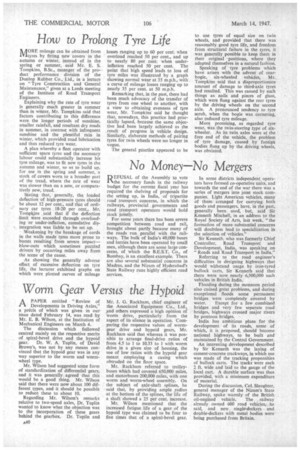How to Prolong Tyre Life
Page 58

If you've noticed an error in this article please click here to report it so we can fix it.
1U4ORE mileage can be obtained from AVItyres by fitting new covers in the autumn or, winter, instead of in the spring or summer, said Mr. E. S. Tompkins, B.Sc., manager of the product performance division of the Dunlop Rubber Co., Ltd., in a lecture on "Tyre Construction and General Maintenance," given at a Leeds meeting of the Institute of Road Transport Engineers.
Explaining why the rate of tyre wear is generally much greater in summer than in winter, Mr. Tompkins said that factors contributing to this difference were the longer periods of sunshine, smaller rainfall, and resultant dry roads in summer, in contrast with infrequent sunshine and the plentiful rain in winter, which provided road lubrication and thus reduced tyre wear.
A plan whereby a fleet operator With sufficient spare tyres and the necessary labour could substantially increase his tyre mileage, was to fit new tyres in the autumn and winter, so as to build up, for use in the spring and summer, a stock of covers worn to a broader part of the tread, where the rate of wear was slower than on a new, or comparatively new, tread.
Stating that, generally, the, loaded deflection of high-pressure tyres should be about 12 per cent:, and that of ordinary car tyres 18-20 per cent., Mr. Tompkins said that if the deflection limit were exceeded through overloading or under-inflation, cumulative disintegration was liable to be set up.
Weakening by the breakage of cords in the walls made tyres more prone to bursts resulting from severe impactblow-outs which sometimes puzzled drivers by occurring miles away from the scene of the cause.
As showing the generally adverse effect of excessive deflection on tyre life, the lecturer exhibited graphs on which were plotted curves of mileage losses ranging up to 60 per cent. when overload reached 50 per cent., and up to nearly 80 per cent: when underinflation reached 50 per cent. The point that high speed leads to loss of Lyre miles was illustrated by a graph showing normal wear at 35 m.p.h., with a curve of mileage losses ranging up to nearly 35 per cent. at 50 m.p.h.
Remarking that, in the past, there had been much advocacy of the transfer of tyres from one wheel to another, with a view to obtaining evenness of tyre wear, Mr. Tompkins' said he thought that, nowadays, this practice had practically lapsed, because the same objective had been largely achieved as the result of progress in vehicle design. Similarly, elaborate methods of pairing tyres for twin wheels were no longer in vogue.
The general practice appeared to be to use tyres of equal size on twin wheels, and provided that there was reasonably good tyre life, and freedom from structural failure in the tyres, it was generally possible to keep them in their original -positions, where they adapted themselves in a natural fashion.
Speaking of tyre problems which have arisen with the advent of rearbogie, six-wheeled vehicles, Mr. Tompkins said that a disproportionate amount of damage to third-axle tyres had resulted. This was caused by such things as nails and pieces of glass, which were flung against the rear tyres by the driving wheels on the second axle. A pronounced tendency to tyre scrub, when the bogie was cornering, also reduced tyre mileage.
More promising, as regarded tyre wear, was the twin-steering type of sixwheeler. As its twin axles were at the fore end of the vehicle, the problem of tyre damage, caused by foreign bodies flung up by the driving wheels, was obviated.




















































































